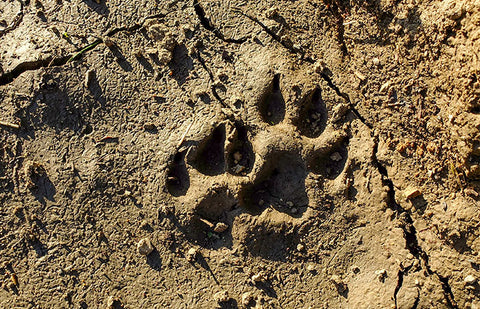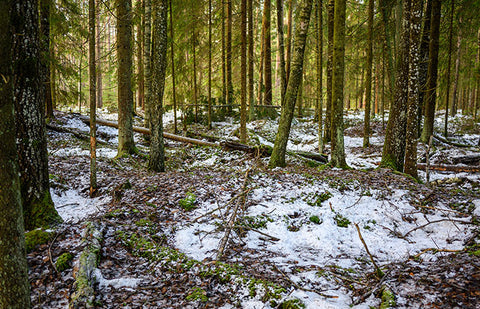Read the Wilderness Like a Book: Adopt These Tracking Techniques Few Have Mastered
In the wild, every leaf turned and every branch broken is a word spoken. Mastering the art of tracking allows you to listen, understand, respond, and read the wild.
This article takes you from basic wilderness tracking to the advanced survival techniques scarce few have mastered. Don’t be one of the sheeple. Read on for expert advice in tracking like a pro when SHTF.
Build Your Foundation with These Tracking Basics
Tracking begins with the ability to identify who has passed before you. It's a fundamental skill for anyone looking to understand the nuances of wildlife behavior or human presence in the wilderness.
RELATED READ: Decoding Wildlife Behavior: These 12 Signs Will Save Your Life

EXAMINE THE SIZE, SHAPE, AND DEPTH
Size – Use a ruler or tracking stick to measure the dimensions of the track. Larger tracks might belong to bigger animals like moose or bears, while smaller tracks could indicate small mammals or birds.
Shape – Look at the overall outline of the track. For instance, bear tracks are typically round with distinct claw marks, while deer tracks are more heart-shaped.
Depth Analysis – Press your hand into the soil nearby. By comparing the depth of your imprint to the track, you can estimate the weight of the animal or person. Heavier beings leave deeper tracks.
Consider the Soil Condition – Soft, muddy ground will show deeper tracks than hard-packed earth. This context is crucial for accurate interpretation.
PATTERN RECOGNITION
Gait Patterns – Animals and humans have distinct ways of moving. For instance, rabbits and squirrels often leave a pattern of four tracks, known as a bounding pattern.
Track Arrangement – Observe the arrangement of multiple tracks. Predators like wolves have a direct register, where hind feet land in the print left by the front feet, indicating a straight, purposeful movement.
ASSESS THE TRACK'S IMPLICATIONS
Movement Speed – Long strides or deep toe marks can indicate running or chasing, suggesting the animal was either predator or prey in a high-speed encounter.
Burden – An unusually deep set of tracks might imply the animal or human was carrying something heavy, potentially leading to food sources or human campsites.
Decoding Nature’s Signs: Unveiling Hidden Messages
Nature is constantly speaking through its signs. By learning to decode these, you gain insights into the recent past and potential future activities in the area.
Scratches on Tree Bark – Can indicate bear presence or deer marking territory. Use a magnifying glass to examine the scratch marks closely; bear claws leave parallel striations, while deer antler rubs show more random abrasion patterns.
Displaced Stones and Broken Twigs – These often mark the passage of larger animals or humans. Place a twig in a similar position and apply pressure to estimate the force required to break it, giving you an idea of the size and possibly the type of animal.
THE ART OF AGING TRACKS: TIME TELLS A STORY
Accurately estimating the age of tracks is like turning the pages of the forest's journal. This skill can tell you how closely you're following your quarry.
Freshness Check – Morning dew settled only within the tracks suggests an overnight passage. Alternatively, if tracks disrupt the dew pattern on the surrounding ground, they're likely very recent.
Environmental Interaction – Observe if leaves or debris have fallen into the track. Fresh tracks will be clean, whereas older tracks may contain such debris, indicating they were made before the last wind or rain event.

Level Up the Basics with These Advanced Techniques
Advanced tracking techniques allow trackers to interpret more nuanced aspects of tracking, offering deeper insights into the behavior and movement of animals and humans.
ANALYZING STRIDE AND PRESSURE
This technique reveals not just the presence, but also the intent and condition of the animal or person. These are invaluable to understanding your target.
MEASURE STRIDE LENGTH
Use a Tracking Stick – Find or make a tracking stick, marking it with measurements. When you find a set of tracks, lay the stick next to the tracks, measuring the distance between them to determine speed. Longer strides typically indicate faster movement, such as running or charging.
Practice with Known Animals – If possible, observe domestic animals or humans walking, jogging, and running over soft soil. Measure and record these strides to create a reference guide for different speeds and gaits.
RELATED READ: Trail Smarts: Find a Missing Person & Avoid Getting Lost in the Outdoors
EXAMINE DEPTH FOR WEIGHT AND BURDEN
Create a Depth Gauge – Use a piece of clay or soft soil next to the track. Press similar force with your finger or a stick to mimic the track depth. Comparing the force needed can give you an approximation of the weight.
Analyze Implications – Deep tracks with more pronounced pressure at the front or back can indicate the direction and speed. For instance, deeper impressions at the toe may suggest the animal or person was accelerating.
PRESSURE DISTRIBUTION TELLS THE TALE
Even vs. Uneven Pressure – Observe if the track shows even distribution of pressure throughout, which suggests a deliberate, cautious pace. Uneven pressure, especially towards the toes, can indicate a quick, possibly alarmed pace.
Simulate to Learn – Practice walking, jogging, and sprinting in mud or snow. Observe how your stride length and pressure distribution change with your speed and intent. This exercise will help you apply these observations in the field.
Mastering Sign-Cutting – Sign-cutting requires a detailed understanding of the environment to follow very subtle signs of passage.
BEGIN WITH CLEAR SIGNS
Find a Starting Point – Look for a set of clear tracks as your starting point. This could be near water sources, along game trails, or human paths.
Practice Fading Tracks – With a partner, create a trail that gradually becomes more subtle. Attempt to follow it, paying attention to how signs become less obvious.

IDENTIFY SUBTLE DISTURBANCES
Train Your Eye – Regularly challenge yourself to notice minor changes in the environment. This could be as slight as a change in the color of grass where it's been pressed down, or a stone that's been flipped over, revealing a wet underside not matching its surroundings.
Use Light – Change your angle of view to catch shadows, or use side lighting in early morning or late evening to enhance visibility of disturbances.
SYSTEMATIC SEARCH WITH A GRID
Create a Physical or Mental Grid – Divide the area around the last known sign into sections. Systematically search each section for any disturbance that may indicate passage.
Practice in Varied Environments – Different environments will offer different challenges for sign-cutting. Practice in both dense vegetation and open terrain to adapt your search techniques to various conditions.
RELATED READ: Surviving the Unthinkable: How to Stay Alive in the World's Most Extreme Environments
REGULAR PRACTICE WITH INCREASING SUBTLETY
Set Up Challenges – Regularly set up tracking challenges with friends or fellow trackers. Start with obvious signs leading to increasingly subtle signs, timing how long it takes to lose and then find the trail again.
Review and Discuss – After each exercise, discuss what signs were missed and why. Learning from each other's observations can significantly enhance your skill.
By progressing through these tactical lessons, you'll transform fundamental tracking knowledge into survival expertise. Mastering these skills ensures you're prepared to face and navigate wilderness challenges effectively.

Diana Smith Hill
Excellent training article- you should also consider droppings—————— can tell the size or the type of animal- example a rabbit dropping will be different from a small cub or a bear or tiger. Droppings identification can let you know immediately the amount of danger that was there or still lingering
rgf
I have never been a Davey Crockett or Indiana Jones but this it well worth time to read, and store in the memory box
Susan
AWESOME information for those of us who frequent the woods around us. Could you recommend a book with all this information? Something we can carry with us.